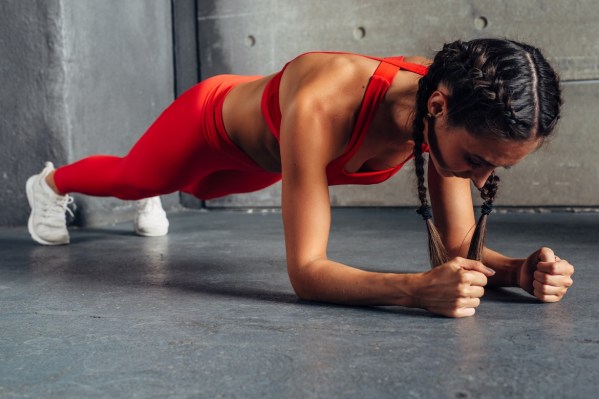If you thought your days of planking were over when you graduated from high school gym class, you may want to reconsider. This classic move provides several benefits that can keep you healthy today and throughout the years ahead.
“Planks are an incredible core exercise,” says Stan Kravchenko, NASM-CPT, a personal trainer and founder of OneFit.com. “Although the physical benefits you may see of tightening your midsection are all the hype, don’t sleep on the real benefits of a solid and strong core. It is so important for many of your daily activities, such as stability and balance—and it is also the basis for many powerful athletic movements.”
Experts In This Article
We’ll dive deeper into the benefits of planks (including those that go beyond stronger abs), along with how to do the move and tips for getting it just right.
In This Article
How to do a plank with the correct form every time
First, getting your form right is key to avoiding injury and reaping the most benefits. Here’s how to properly do a plank on your forearms, according to Kravchenko.

- Lie face down with your forearms on the floor and your elbows directly beneath your shoulders. Keep your feet flexed with the bottoms of your toes on the floor.
- Press the floor away from you with your forearms and rise up on your toes so that only your forearms and toes touch the floor.
- Maintain a straight line from the top of your head to your ankles.
- Squeeze your glutes, tuck your tailbone under and gently pull the elbows towards your toes for maximum engagement of your core.
- Avoid sagging your hips, arching your back, or tilting your head up.
- Hold for time.
“You should aim for a 1-minute plank,” Kravchenko says. “However, if you are just starting, you may only be able to hold the position for 30 seconds.”
If you’re in the 30-second group, repeat your plank up to three times in a set (progressing in 5-second increments each time) as you build strength.
“No gym, no problem—this exercise is so great because it can be done anywhere.” —Natalie Kollars, CPT
Benefits of planks you’ll love
Let’s start with the obvious one: Planks are a fantastic exercise for your core muscles.
While toned abs may come top of mind, the real benefits go far beyond that. Core stability is important for most human movements.
“Adequate core strength and stability is required to safely perform exercises such as the squat and deadlift, but it’s also important for activities outside of the gym such as hiking, running, biking, playing with our kids, and so forth,” says Natalie Kollars, CPT, a strength coach and owner of the online coaching platform Fortis.
Plus, it can also help support the rest of your strength training.
“Core stability is vital to lifting heavy weights,” Kravchenko says. “To train effectively and minimize injury, build a strong core for a better foundation to move heavy loads.”
While your abs will certainly benefit from planks, there are even more perks of adding them to your workout. Here are four more benefits of planks that go beyond just stronger abs.
1. They support balance
Planks also help you to balance better, a key element of many other exercises and everyday life.
“Strengthening your core improves dynamic balance,” Kravchenko says. “This core exercise focuses on the conditioning of the deep trunk muscles that work together to stabilize the spine.”
A June 2022 study in the British Journal of Sports Medicine found an association between the ability to balance and longevity in older adults: Those who couldn’t balance on one foot for 10 seconds were twice as likely to die within a median follow-up period of seven years than those who could.
As you age, exercises that improve balance become particularly important. Balance quickly diminishes after the mid-50s, which increases the risk for falls and other negative health outcomes, per the study authors.
2. They stabilize your shoulders
Practicing planks helps to strengthen and stabilize your shoulders, which has several benefits.
“Healthy shoulders are important in and out of the gym,” Kollars says. “Since they have a large range of motion or mobility, having proper shoulder stability is very important.”
Shoulder instability can lead to pain, the ball of the shoulder popping out of its socket, a decreased range of motion, and swelling or bruising, according to Johns Hopkins Medicine. It typically occurs when the parts of the shoulder joint or ligaments become stretched, torn, or detached.
3. They improve your posture
You may find that incorporating planks into your routine helps you stand up a little straighter.
“Weak and unbalanced core muscles can result in slouching,” Kravchenko says. “Good posture is essential for reducing the risk of herniated discs and spinal degeneration. Better posture also assists with improved breathing and the opening of your airways.”
Good posture naturally involves braced abdominal muscles and a neutral spine, per Harvard Medical School. When weak core muscles encourage slumping, your body is tipped forward and off balance. Core strengthening exercises like planks can help prevent this.
4. They boost your everyday mobility
When you have better core strength from practicing poses like a plank, you’ll lower your risk of injury during everyday tasks like carrying groceries or walking upstairs (which require core strength).
“A strong core gives you better control of your muscles, increasing agility or adaptability for an easier recovery if you lose your balance,” Kravchenko says. “You’re less likely to strain other muscles like your legs, back, and hips if your core is strong.”
Maintaining mobility is key for good functioning and independent living as you age, per the National Institute on Aging. Older adults who lose mobility are less likely to live at home and have poorer quality of life. They also have higher rates of disease, disability, hospitalization, and death.
Plus, because planks don’t require any equipment, they are accessible for most people to try at home.
“No gym, no problem—this exercise is so great because it can be done anywhere,” Kollars says.
The muscles you work when doing planks
A plank strengthens your core, upper body, and lower body, all at once. Here are key muscles worked during a plank, according to Kollars:
- Core: transverse abdominis (deepest ab muscle), rectus abdominis (“six-pack” muscle), obliques (muscles on the sides of your torso)
- Upper body: deltoids (shoulder muscles), lats (mid-back muscles), rhomboids (upper-back muscles), traps (upper-back muscles)
- Lower body: glutes (butt), quads (front of thighs), hamstrings (back of thighs), calves (back of legs)
“Pretty much the entire body is worked when you do a plank,” Kollars adds.
Tips for beginners trying planks
If you’re new to planks, don’t force yourself into 1-minute holds right away. Pushing too hard from the get-go can lead to poor form, like slumping hips.
“Start with short holds and gradually increase your time by five to 10 seconds,” Kollars says. “I coach my athletes and clients to keep their body straight as a board.”
There are many variations of planks—and you can apply modifications if you’re new to planks.
“Aside from decreasing the time you hold the position for, you can also adjust the position,” Kravchenko says. “I’d suggest a tabletop plank or an incline plank if the standard form is too difficult. You can continue to build strength there and progress with longer increments.”
For a tabletop plank, keep your legs bent and lifted just slightly off the ground. Meanwhile, for an incline plank, place your hands or forearms on an elevated surface like a bench.
Safety tips and precautions to keep in mind during planks
Form is key for safety and injury prevention with planks.
“Always ensure you have the proper form and listen to your body,” Kravchenko says. “Take the time to get into the proper position. If you ever need help with your form, consult with a coach or trainer.”
Remember, even if the plank is challenging for you, it shouldn’t be painful.
“You should not do planks if you have a shoulder injury or feel shoulder pain during the exercise,” Kravchenko says. “If other injuries are present or you’re pregnant, you should always consult with your doctor first to ensure it’s an appropriate exercise for you.”
FAQ
1. How many minutes should I do a plank per day?
Everyone’s threshold will be different, but aim to start with a 1-minute plank per day.
“Some individuals may start with only 10-second holds, which is just as great,” Kravchenko says. “Over time, you can work up to 30-, 45-, or 60-second holds.”
How long you can hold your plank will depend on your strength and experience level—over time, your total plank time can exceed one minute (even if this is broken into different sets).
“It should only be held for as long as perfect technique can be maintained,” Kollars says. “I recommend holding planks for 20 to 60 seconds and performing three to five sets.”
2. What happens if I plank everyday?
Repeating exercises and increasing intensity over a period of time can help you progress and build strength.
“If you do a plank every day, you’ll likely see the benefits even faster,” Kravchenko says. “In addition to the benefits like improved posture and balance. you’ll also likely experience muscle growth and endurance.”
That said, it’s certainly not necessary to plank every day to reap the benefits. Kollars points to the importance of taking rest days, too, and recommends three to four planks per week.
“Giving your body enough rest to recover allows it to reap maximum benefits from the exercises you perform,” Kollars says.
3. Is a standard plank or side plank better for core strength?
These two forms of planks will target different muscles—something to keep in mind as you work them into your workout routine.
“For overall core strength, the standard plank is superior to the side plank,” Kollars says. “While side planks primarily target the obliques, they offer less overall engagement of the core muscles compared to the standard plank.”
But if you’re looking for a better oblique workout, opt for the side plank.
“Your obliques are the muscles that run alongside your core—think the muscles that corset you up,” Kravchenko says. “This variation will also target your obliques more than a regular plank.”
Well+Good articles reference scientific, reliable, recent, robust studies to back up the information we share. You can trust us along your wellness journey.
- Araujo CG, de Souza E Silva CG, Laukkanen JA, Fiatarone Singh M, Kunutsor SK, Myers J, Franca JF, Castro CL. Successful 10-second one-legged stance performance predicts survival in middle-aged and older individuals. Br J Sports Med. 2022 Sep;56(17):975-980. doi: 10.1136/bjsports-2021-105360. Epub 2022 Jun 21. PMID: 35728834.
Source: Well and Good






